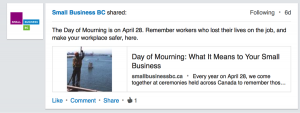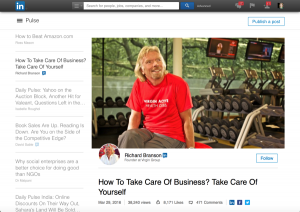LinkedIn Publisher as a Content Marketing Platform
The list of content marketing platforms continues to grow. And one newish platform I’ve been testing out recently on behalf of a client is LinkedIn Publisher.
As you know, for a long time LinkedIn has allowed users to share “updates” and links with people they’re connected to. Similar to Facebook and most other social media platforms, users provide a brief contextual write up and a link if desired. The post displays with an accompanying image (if supplied) and summary.
Connections who view the post are invited to like, comment and/or share the post.
While I like this tool as a content sharing platform, one downside is that it provides limited stats. For example, with a basic account, you can only see the number of views of your last status update. You can’t see the number of views of your previous updates. (Although I believe LinkedIn business accounts provide more robust stats.)
How LinkedIn Publisher is Different
But recently, LinkedIn rolled out another content sharing option: LinkedIn Publisher. LinkedIn Publisher allows you to upload an entire post that resides on the LinkedIn platform (as opposed to providing a link to a post that lives on your own website or elsewhere).
Now, you and your marketing team may not be too keen on having to generate another original stream of content. However, some companies and marketers are taking the approach of re-posting content on LinkedIn Publisher that they originally published on their websites.
If you decide to go this route, keep a few things in mind:
1. Wait before publishing
To avoid issues of duplicate content on Google, wait a few days before republishing the content on Publisher. This will give time for Google to index the content on your site first.
How long do you have to wait? Some say two days, some say two weeks (!) If you’ve set up a Google alert on your company name (and you should) then you’ll have a rough idea of how long it takes Google to find and index your posts.
2. Indicate where the post was originally published
As a courtesy to readers, indicate at the end of the post where the post was originally published. Include a link to your original post (and also to your home page if desired).
3. Use custom URLs to track
In addition, if you want to see if the post is generating any traffic, use Google Analytics’ campaign URL builder to track clicks.
Have you tried using LinkedIn Publisher yet? Did it generate much action for you?


